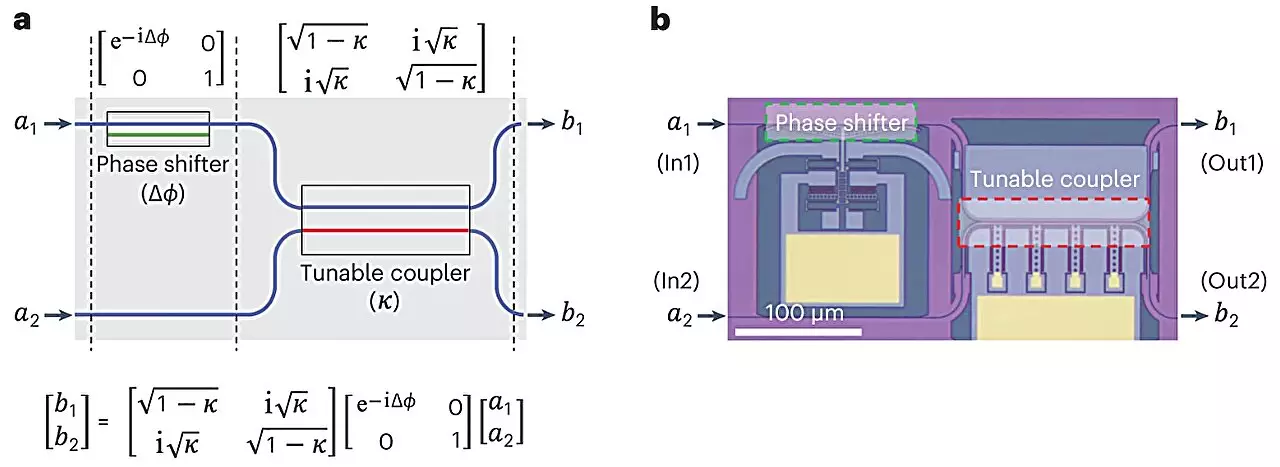In recent years, there has been a growing demand for faster, more efficient, and highly parallel computing capabilities. The use of programmable photonic integrated circuits (PPICs) has emerged as a potential solution to this challenge. Researchers at the Daegu Gyeongbuk Institute of Science and Technology (DGIST) and the Korea Advanced Institute of Science and Technology (KAIST) have made significant progress in incorporating microelectromechanical systems (MEMS) into PPICs. Their groundbreaking research, published in the prestigious journal Nature Photonics, holds the potential to revolutionize various fields, including artificial intelligence, neural networks, quantum computing, and communications.
Programmable photonic processors have the capacity to outperform traditional supercomputers, offering unmatched computing capabilities. Unlike electric current, the use of light waves allows for faster processing speeds. Additionally, PPICs demonstrate a substantial reduction in power consumption and size, which could lead to significant advancements in multiple domains. Sangyoon Han, a member of the DGIST team, underscores the importance of these advancements and the potential impact they can have on the future of technology.
At the heart of this breakthrough lies the successful integration of microelectromechanical systems into PPICs. MEMS are miniature components that have the ability to interconvert optical, electronic, and mechanical changes, enabling a wide range of communication and mechanical functions within an integrated circuit. The research team at DGIST and KAIST have been pioneers in integrating silicon-based photonic MEMS technologies onto PPIC chips, while simultaneously operating at extremely low power requirements. Han proudly highlights this achievement, pointing out that their innovation has resulted in a remarkable improvement of over a million times in power consumption compared to previous state-of-the-art systems.
A key aspect of this breakthrough is the departure from the traditional dependence on temperature changes characteristic of existing “thermo-optic” systems. Instead, the researchers have harnessed the power of electrostatic forces to facilitate the required tiny mechanical movements. By manipulating the phase of light waves and controlling the coupling between parallel waveguides, the team has successfully addressed the fundamental requirements of building PPICs. These capabilities, combined with the integration of micromechanical actuators, have culminated in the development of a programmable integrated circuit that operates with significantly reduced power requirements.
The success of this research can be attributed to the application of innovative concepts in the fabrication of silicon-based PPIC components. Importantly, these manufacturing techniques are compatible with conventional silicon wafer technology, enabling large-scale production of photonic chips. This compatibility plays a pivotal role in realizing the commercial potential of PPICs in various applications. The researchers plan to further refine their technology, with the ultimate goal of developing and commercializing a photonic computer that surpasses traditional electronic computers in a wide range of use cases.
The potential applications of PPICs are vast and promising. One notable application lies in the field of artificial intelligence, particularly in inference tasks. PPICs have the capacity to significantly enhance the speed and efficiency of advanced image processing. Furthermore, their ability to facilitate high-bandwidth data transmission opens doors for the improvement of communication technologies. As the researchers at DGIST and KAIST continue to push the boundaries of computational technology, the practical applications of photonics will undoubtedly expand, leading to transformative advancements in modern technology.
The integration of microelectromechanical systems into programmable photonic integrated circuits represents a pivotal step towards revolutionizing computing capabilities. With their ability to process light waves for computation, sensing, and signaling, PPICs offer unparalleled advantages over traditional supercomputers. The reduction in power consumption, coupled with their compact size, opens up new frontiers in fields such as artificial intelligence, neural networks, quantum computing, and communications. The groundbreaking research conducted by the DGIST and KAIST teams paves the way for future advancements in this exciting field of photonics, unlocking unprecedented possibilities for technological innovation.


Leave a Reply